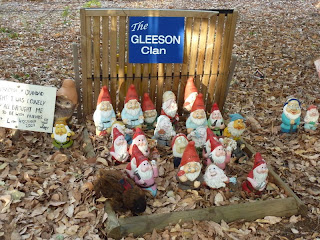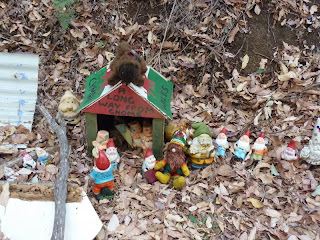Our tour guide Proek Preang, whose name in the official language Khmer means "morning" that was chosen by his parents because he was born in the morning, had just finished his degree in IT at a university in Phnom Penh, which costs $400 US per year. While he had studied English, the tour information that we received stated that most tour guides "have limited English skills, but their local knowledge, willingness, friendliness and enthusiasm deserve special merit." PP, as we will call him, excelled in all of these attributes. Sara, who thought she could understand almost anyone who studied English as a second language, caught about every third word. Fortunately, PP repeated everything three or four times so we were able to piece together most of what he told us, except for his jokes, in which we case we all laughed at what seemed to be the appropriate places.
As Baby Boomers, when we think of Cambodia, we think of a painful part of our country's history, the shootings at Kent State in 1970--"Four Dead in O-Hi-O"--that contributed to the end of the United States' involvement in Vietnam, the book and movie "The Killing Fields" and the Khmer Rouge also come to mind. The people in Cambodia have suffered, and the country has been devastated. During that period, any citizen who showed intelligence was shot, which included having a white band around the wrist from where the person wore a watch. Many children grew up as orphans or with only one parent. Quoting from the Adventures Ashore Port Guide from Princess Cruises, "Without the rich memories of this very ancient culture, rebuilding a shattered land might be too difficult. But Cambodia has a long memory, and its gentle people savor that legacy with respect and love."
PP told us that Cambodia's king was 58 and single. The party in power at this time is the Cambodian People Power Party. Of the total population, 40 percent, who are poor, and 40 percent, who are middle class, live in the country while the remaining 20 percent, who are rich, live in the cities. We drove past the Diamond Sea, where rich people are married while poor and middle class people are married in their homes. A person with a car is rich. If a man wants to get married, he must have a job in which the average salary is $300 a month. The woman's parents agree to the marriage in which the woman has no choice and sometimes cries because she does not love the man. The man pays from $2,000 to $3,000 for a girl from the country and $5,000 or more for a girl from the city. PP confided that if he marries in the near future, he will go to the countryside to chose his bride.
With the mean age being 22.6, one-half of the population was not born until after the Vietnam War, so Cambodia and Vietnam are friends. During the Vietnam War, Sihanoukville, which means "Star of the South," was transformed from a sleepy little fishing village to an important deep water port. The two seasons here are dry from November to April and wet from May to October. The three main parts of the land are low, plateau and mountain.
Our first stop was Wat Krom, the "Lower Temple" on Mt. Sihanouk. There our guide explained to us about the stupas or burial monuments for rich people whose ashes are brought there. A stupa cost about $500 US. He also explained the stories behind many of the statues, which include the one where the Buddha was smiling at his students and the one of the Buddha who has passed from this earth with four students crying and one student happy. When asked why the student was happy, Sara immediately thought because he was pleased that the final exam had been canceled for the funeral. The real answer was that the four students were crying because they had lost the best teacher they had ever had and the one student was happy because the teacher was going to paradise.
The next statue demonstrated that the Buddha could walk one step when he was born. The Buddha also raised one finger in the air because he was the only newborn baby in the world who could walk. At the next statue, we learned that at age 29, the Buddha took a white horse into the forest where a giant asked him why he left his palace, wife and son. The Buddha said, "Get away. I don't have to have a reason. I just want to go to the forest." After the white horse and the fitter left, the Buddha lived in the forest until he received wisdom at age 35. He died at age 80. We kept hearing what sounded like gun shots but was really fireworks. We also learned that the lion and snake are important because they offered protection to the Buddha with the snake protecting him when he died.
We then visited a home of a middle-class family, where the woman seemed to have a serious goiter problem. Punxsutawney Phil had his photograph taken at a jackfruit tree, which PP dubbed the fruit as "delicious." Other trees in the yard included papaya and orange. Five people slept in the upstairs bedroom. On the walls were photographs of smiling brides and grooms and a certificate for a man who had completed the training course for the Cambodian Police Force. The combination kitchen and dining room was in a separate building. The crock pot looked similar to one that we own, as did the many sauces and spices for the food. Of interest were the toothbrushes hanging near the kitchen sink. The bathroom, which was in a separate building, was out of order. Would you want your 40 new, best friends using your toilet?
The most interesting stop on our tour was the local government primary school, which was free for the children. The school operated two shifts: one from 7 a.m. to 11 a.m. and the other from 1 p.m. to 5 p.m. The students attend primary, secondary and high schools free and then may go on to the university for $400 U.S. per year. In the library was a donation box and an English to Khmer Dictionary. The Grade 6 students stood and sang a song for us while the Grade 4 students played a tune on their blow tube pianos. Chickens and children, who were probably waiting for the second shift, ran freely in the playground and yard. Ken reported that the teachers' restroom was very primitive.
On our trip to the market, we passed the monument of the Golden Lions in a traffic circle that expresses sthe optimism that Cambodia's future can build on the glorious memory of the past. While we would have gladly skipped the market, we would have missed an important slice of daily life. Then we were off to the Sokha Beach Resort, a first-class luxury resort with white-sand beaches. There we drank Ankor beer and shared one lounger under a thatched umbrella-like cover listening to the waves break on the shore--probably one of the most relaxing setting ever.
On the way back to the ship, we passed a monkey farm. PP told us the 10,000 monkeys live in this area. Ken took pictures of one monkey giving another a back and head massage--very sweet. While we will probably not put Cambodia on our list of countries we must visit again, we are very glad to have had this experience and learn more about this country that has lived through devastation. While its recent past has been tragic, its people look forward to the future with great hope.

























































